More on the Undercurrents series
This is part of a year-long project in which Doug Saunders explores the global migration crisis, and the political and economic forces driving it. Learn more in the Decibel episode below and our companion explainer on this series.
Tan-Tan: Where desert meets Europe
As the first glow of dawn broke over the hills of the northwestern Sahara, a battered white minivan came to a stop and disgorged half a dozen men. Khalifa Barry, at 17 the youngest and smallest of the group, scrambled to the top of a rocky crest in his plastic flip-flops and gazed across the horizon. He estimated it was at least an hour’s walk across the dunes to Tan-Tan, the southern Moroccan town they’d paid $10 each to be driven to. The driver had unapologetically dumped them in this barren expanse and driven off, probably to avoid the police checkpoints that bar undocumented migrants, like these men, from entering the city.
After shouting to the others to follow him, Khalifa pulled out his phone, panned its camera around the austere sunrise vista, and marvelled at the sight: “Gosh, the Sahara is beautiful! I love the views,” he exclaimed, with an untarnished enthusiasm that had propelled him across thousands of kilometres. “It’s so cool.”
Roadside betrayals and sun-blasted walks through the desert are nothing new to Khalifa, who had already crossed the Sahara once, in a solo journey that began when he ran away from home at the age of 14. That years-long trek took him from his hometown in the forested centre of Guinea, across the desert expanse of Mali and Algeria, and then into great danger in Tunisia and Morocco – all the time surrounded by scores of other Black Africans traversing the same route, for hundreds of different, ever-shifting reasons.
Tan-Tan, just north of the border of the contested territory of Western Sahara, is one of the terminal points of the trans-Saharan migration pathway, a handful of roads and paths spanning thousands of kilometres between sub-Saharan Africa and the Mediterranean coasts of Libya, Tunisia, Algeria and Morocco; together, these form one of the world’s most economically important, politically charged and deadly human-migration routes.

SPAIN
ITALY
Ceuta
Algiers
Casablanca
Tunis
MALTA
Oujda
MOROCCO
Tripoli
Melilla
Medinine
Canary
Islands
Agadir
ALGERIA
Tan-Tan
Sabha
LIBYA
MAURITANIA
MALI
CHAD
Gao
Agadez
Mamou
Bamako
Kano
GUINEA
500 km
THE GLOBE AND MAIL, SOURCE: UNHCR

SPAIN
ITALY
Ceuta
Algiers
Casablanca
Tunis
MALTA
Oujda
MOROCCO
Tripoli
Melilla
Medinine
Canary
Islands
Agadir
Sabha
ALGERIA
Tan-Tan
LIBYA
MAURITANIA
MALI
CHAD
Gao
Agadez
Mamou
Kano
Bamako
GUINEA
500 km
THE GLOBE AND MAIL, SOURCE: UNHCR

ITALY
SPAIN
Ceuta
Algiers
Atlantic
Ocean
Tunis
Melilla
MALTA
Mediterranean
Sea
Oujda
Medinine
Tripoli
Casablanca
TUNISIA
MOROCCO
Bechar
Agadir
Canary
Islands
ALGERIA
Tan-Tan
Sabha
EGYPT
LIBYA
WESTERN
SAHARA
Tamanrasset
MAURITANIA
MALI
Nouakchott
NIGER
Timbuktu
Agadez
CHAD
Gao
SUDAN
SENEGAL
BURKINA
FASO
GAMBIA
Ndjamena
Bamako
Kano
GUINEA
Mamou
NIGERIA
CÔTE
D'IVOIRE
GHANA
500 km
THE GLOBE AND MAIL, SOURCE: UNHCR
EQUATORIAL GUINEA

ITALY
SPAIN
Atlantic
Ocean
Algiers
Tunis
Ceuta
MALTA
Mediterranean
Sea
Melilla
Oujda
Medinine
Tripoli
Casablanca
TUNISIA
MOROCCO
Agadir
Canary
Islands
ALGERIA
Tan-Tan
Sabha
EGYPT
LIBYA
WESTERN
SAHARA
Tamanrasset
MAURITANIA
MALI
NIGER
Timbuktu
Agadez
CHAD
Gao
SUDAN
SENEGAL
BURKINA
FASO
GAMBIA
Ndjamena
Bamako
Kano
GUINEA
BENIN
Mamou
NIGERIA
CÔTE
D'IVOIRE
GHANA
500 km
THE GLOBE AND MAIL, SOURCE: UNHCR

ITALY
SPAIN
Algiers
Atlantic
Ocean
Ceuta
Tunis
Melilla
MALTA
Mediterranean
Sea
Oujda
Medinine
Tripoli
Casablanca
TUNISIA
MOROCCO
Agadir
Canary
Islands
ALGERIA
Tan-Tan
Sabha
LIBYA
EGYPT
WESTERN
SAHARA
Tamanrasset
MAURITANIA
MALI
NIGER
Timbuktu
Agadez
SUDAN
CHAD
Gao
SENEGAL
BURKINA
FASO
GAMBIA
Ndjamena
Bamako
Kano
GUINEA
BENIN
Mamou
NIGERIA
TOGO
CÔTE
D'IVOIRE
GHANA
500 km
THE GLOBE AND MAIL, SOURCE: UNHCR
Many of those migrants, like Khalifa, began their journey in West Africa. Using the trans-Saharan pathway, hundreds of thousands make their way up the continent, seeking work, permanent or temporary, in the more prosperous economies of North Africa. But starting around 2003, tens of thousands of those migrants each year risked further sea voyages to find employment in the even more labour-hungry economies of Europe.
The journeys of Khalifa’s peers – at least the minority of them who attempt to cross to Europe – have provoked multiple political crises on the continent this year. In Germany, the settlement of hundreds of thousands of migrants from the Middle East, Central Asia and Africa (plus a million Ukrainians) during the past two years has contributed to a rise in support for far-right parties. In Britain, a smaller number of asylum seekers, some of them African, crossing the English Channel on fishing boats has resulted in draconian laws that propose to deport large numbers of them pre-emptively to Rwanda. Italy’s right-wing government this summer seized ships used by charities to rescue migrants capsized at sea, after banning them from making multiple rescues.
But what I found, after spending weeks speaking and travelling with migrants on the trans-Saharan route, is that Western policies intended to secure borders and reduce smuggling and illegal migration are creating perverse incentives that all but force many legitimate labour migrants and asylum seekers to choose dangerous, illegitimate routes.
The illegal boat crossings are not a constant. They dwindled to negligible numbers for years after the 2008 economic crisis (when there aren’t jobs in Europe, Africans generally don’t try to come), then picked up during the Arab Spring uprisings of 2011, then died down for a few years until the big 2015-16 surge coming mainly from the Middle East, and then died out again during the peak pandemic years. And sub-Saharan Africans have generally been a minority aboard the boats.
The more recent upsurge, propelled by strong demand for agricultural labour in Italy and Spain, has seen the Atlantic route between Morocco and Spain’s nearby Canary Islands become a mass phenomenon again for the first time since the 2000s – more than 25,000 people left Morocco for Europe in the first nine months of 2023. That’s less than half the number that departed Tunisia and Libya for Italy, but figures show that trans-Saharan migration is shifting westward, as Libya, Tunisia and Algeria become violent and dangerous places for migrants.
The boat trip over the open Atlantic to the Canaries, however, is considered the deadliest of all routes to Europe; a series of capsizing incidents this summer saw at least 600 Africans drown off the Atlantic coast of Morocco. Many of those fatal journeys began on the beaches near Tan-Tan.
I first met Khalifa in Agadir, a city of about a million people midway along Morocco’s Atlantic coast that serves as a crossroads and, increasingly, as a place of permanent settlement for sub-Saharan migrants. A few days later he would board the midnight van to the outskirts of Tan-Tan, where we would meet again.
I had come to Morocco to follow migrants along the busiest and most important crossroads of the trans-Saharan route, and to find out how their decisions are shaped by the shifting policies of North African and European countries, the European Union and their home nations.
African migration has been transformed dramatically by the fact that even the poorest migrants now have smartphones and constantly communicate with one another using WhatsApp and Signal. This means that they almost immediately become aware of fast-changing policies and opportunities in faraway lands – or at least aware of rumours, sometimes incorrect, about those policies – and act upon them.
Khalifa was one of those constant decision makers, though one with a rather extraordinary story, and a unique ability to tell it. He first approached me while I was interviewing a migrant from Mali in an Agadir rooming house known as Mama Africa. I was interrupted by a petite, neatly dressed figure who politely informed me that my French-to-English translation wasn’t quite right. He grabbed my notebook and offered to correct it. “I have a real passion for the English language,” he told me. “It was learning English that first made me leave home and try to come to Europe.”
By this point, almost three years into his journey, Khalifa was confronted with another major life decision: From Tan-Tan, he could either cross the Sahara once again, back south through Western Sahara, Mauritania and Senegal to his family in Guinea, or he could borrow thousands of dollars or work for months to pay one of the city’s many smugglers to take him on an illegal and potentially deadly boat trip to the nearby Canary Islands, to realize his dream of living in the European Union.
Most of his companions from the van were taking that dangerous European path. But Khalifa was not so sure. He knew some things they didn’t, and had the scars, both physical and emotional, to show for it.
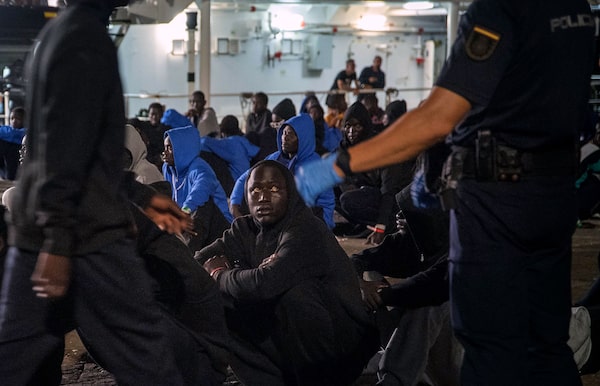
Migrants sit on the pier in Granadilla, a port on the Spanish island of Tenerife, this past Oct. 5, after the Spanish Civil Guard vessel intercepted a group of 496 people.DESIREE MARTIN/AFP via Getty Images
It’s estimated that between 65,000 and 120,000 people a year traverse the Sahara, mostly using the services of smugglers. During the first two years of the pandemic, that number dwindled to a few thousand, and transit cities such as Agadez, Niger, and Gao, Mali, whose economies are built on the movement of migrants, suddenly became destinations, with many West Africans stuck there for years – the “involuntary immobile,” as scholars call them. During “normal” years, recent figures show that 30,000 to 40,000 migrants a year pass through these cities to Algeria and Morocco; until the 2010s, about 300,000 a year would cross into Libya, although that number has declined sharply. The number of West Africans who attempt to cross to Europe is typically about 20 per cent of this total.
The trans-Saharan routes follow a small handful of roads and transit cities with end points in Libya, Tunisia, Algeria and Morocco (there is also an eastern branch, leading from Sudan, through Chad and into Libya). Most have been used for trade and commerce and warfare for centuries, carrying camel caravans, mule-pulled wagons, flatbeds and white Toyota pickups across the desert.
Europe’s booming economies relied heavily on African labour from the 1960s onward, but until the 1990s, workers generally flew to European airports for seasonal employment, or, in the case of Moroccans, were brought over by the hundreds of thousands as “guest workers.” But the newly formed European Union’s elimination of visa-free labour migration – ostensibly as a way to control the bloc’s external borders – drove seasonal-work migrants, unable to obtain visas, into the hands of a newly created smuggling industry. The smugglers’ fees for boat crossings – typically many thousands of dollars – could not be repaid with only one season of work, so the migrants had to stay longer and send money back to their families. The boats became an industry in the early years of the 2000s, with drowning deaths first making front-page headlines in 2003.
The Africans who set out across the Sahara and sometimes onward to Europe are not, contrary to popular image, deeply deprived villagers fleeing poverty, destitution and violence.
The closest thing we have to a census, a 2019 representative survey in which more than 3,000 trans-Saharan migrants were interviewed in detail by the United Nations Development Programme, found that they have more formal education than the average person in their home country (three years more education for men, five for women, and about one in 10 Saharan migrants has a university education). Their incomes in their home countries were 63 per cent higher than the national average – perhaps not surprising, given that the average price paid for a smuggler journey to Europe is $3,700 a person. And they overwhelmingly tended to be urban.
The motivations for migration also tend to be positive – the word “fleeing” isn’t accurate. While many migrants I met were getting out of what they felt were worsening situations in the African “coup belt” – the string of countries, including Guinea, Mali, Niger, Chad and Sudan, that have recently experienced military overthrows of elected governments – they all said the political turmoil simply motivated them to seek better opportunities. As another major study of migrants concluded, migration out of Africa is not being driven by “poverty, violence and underdevelopment,” but much more frequently by “processes of development and social transformation which have increased Africans’ capabilities and aspirations to migrate.”
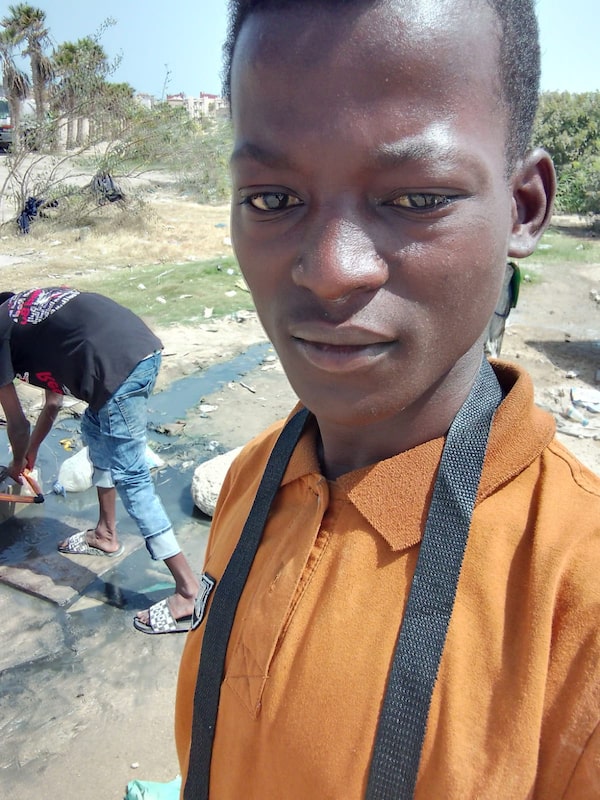
Khalifa stops to get water near Dakhla, Western Sahara, during his months-long trek across the desert.Courtesy of Khalifa Barry
Khalifa’s family are part of that picture. They certainly aren’t wealthy by any standard, but they make a decent living: His father runs a popular coffee shop in the centre of their town. When Khalifa was young, they had enough money to send him to a private school across the border in Sierra Leone, a former British colony where he and his older brother learned, and became obsessed with, the English language and the countries where it’s spoken.
“I didn’t really have friends when I was young, because I was interested in different things – I just read books and read things online in English, I didn’t want to play with anyone,” he told me. “At that age, when I was 5 or 6, I was thinking, yeah, this English is very beautiful, and I kept thinking, maybe I can have job opportunities in America or England with this.”
He immersed himself in school. But when Khalifa was almost 15 and had reached the equivalent of Grade 11, his parents could no longer afford the fees. They told him he’d have to finish his education in French in Guinea, and earn some money while he was doing it to help with the household budget. This broke his heart, and gave him an idea. There was a guy in his town who’d gone to Europe, and found work in France. When that guy visited every couple years, he was received like royalty. Young Khalifa, like everyone his age, knew about the trans-Saharan roads and the ways to Europe. He proposed it to his mother and, like any parent would, she refused: He should stay, finish his education and get his ID papers so that, once he turned 18, he could enjoy real freedom.
So the morning he left, he didn’t tell anyone – just penned a note for his mother, telling her not to worry. He hitchhiked to the border of neighbouring Mali, then spent about a month getting rides and asking for donations as he passed through the chaotic transit towns. The green forests gave way to scrub and then to the colourful rocks of the desert and then to sand. At the Mali-Algeria border town of El Khalil, he and some other Guineans worked odd jobs, washing cars and the like, until they could afford to pay a “taxi mafia” driver to smuggle them across the border. It was then near the peak of the pandemic lockdowns, when the economies to the north were all but stalled, so very few sub-Saharans were crossing that border and the smuggling fees were lower. They continued on, working their way up the long dusty slog of Algeria, stopping here and there for a month to work at day-labour jobs to afford the next leg. It’s a well-established ritual of the Saharan crossing.
Northern Algeria is no longer a safe place for Black Africans. In response to EU payments, the governing regime routinely rounds up all the migrants it can find near the beaches and deports them back to Mali, often stopping to beat them with batons. So Khalifa stealthily made his way east, and across the comparatively unguarded border into Tunisia.
There, he eventually met an older woman from Tunis who took him in. She ran a street restaurant and gave him work, preparing food and getting supplies, letting him live in her house. It was a good life, and he briefly considered staying. But after a few months, he started to remember his dream. The West Africans on his WhatsApp were telling him about Morocco: It was the better option for getting to Europe. He bade a teary farewell to the woman and made the slow journey westward, to the high walls of razor wire, drone cameras and guard dogs that mark the Moroccan border.
Khalifa’s roommate during his stay in Tan-Tan was fellow Guinean Alpha Diallo, 21, a young man with a perpetual grin and an irrepressible sense of adventure to rival his friend’s – and a very similar origin in Guinea and path to Morocco through Mali and Algeria. Diallo, however, was far more certain about his destination.
The oldest in his family, he realized he needed to drop out of school to support his sisters’ education. He followed a similar path to Khalifa – persuading people to give him rides, sneaking across borders at night. But when he made it to the Mediterranean city of Oran, Algeria, he stayed for more than a year, working a variety of jobs and saving a few thousand dollars in cash. “I told my friend, we have a lot of money to go to Spain but there’s no good way to get to Europe from here. Let’s get together and find a connection in Morocco to cross through the water. He said that’s a great idea, so we put together a team.”
The perilous boat voyage to Europe is usually taken because there are specific rewards at the other side: Both Spain and Italy report serious agricultural labour shortages, which suggest that not enough Africans are arriving. The destination for migrants like Diallo is southeastern Spain, where Europe’s largest expanse of greenhouse agriculture is dependent entirely on African labour (about half the region’s 120,000 farm workers are Moroccan and half sub-Saharan).
Spain even has a pathway to legal residency for a few of these workers. But, owing to EU border policy, Spain does not offer many safe, legal ways for these farm workers to enter the country – meaning that most of these legal employees still enter on unlawful, dangerous boat crossings costing them thousands of dollars.
To attempt that crossing, Diallo and his mates took a series of buses across Morocco, stayed in the squalid migrant camps of Casablanca for a couple months and then in Agadir, and then headed to Tan-Tan. The Moroccan police stopped them along the way, told them they knew exactly what they were attempting and pointed out that Morocco had banned boat crossings – and then requested bribes of 50 dirhams (about $7) each, before letting them go.
In Tan-Tan, they met their smuggler, who was almost certainly connected to a local criminal gang that also used the boats for drug smuggling. He demanded US$3,000 each.
Two days later, 64 migrants – both Moroccans and West Africans, including several entire families – piled into a seatless bus late at night and made a jarring half-hour ride to a lonely stretch of Atlantic beach. A fishing boat rested in the shallows. They loaded the larger men into the bow first, then women and young children into the cabin, then the rest of the men, including Diallo, around the decks. The boys pushed the severely overloaded boat off the sand, and it rode low in the choppy water.
The Canaries are less than 150 kilometres from the Moroccan coast, so the journey should take only a few hours – but owing to rough waters and poor boats, migrants often find themselves stuck at sea for days. Diallo didn’t suffer this fate the first time – after two hours in the waves, their boat was intercepted by the Moroccan Marine Corps and sent back to Agadir, further north. The smuggler, when Diallo reached him on his phone, promised them he’d give them another trip. The night after I spoke to Diallo, he boarded another bus to the beach. (That trip was also unsuccessful, because of a failed motor. He is currently planning a third.)
Khalifa was also preparing to get on a vehicle – he just needed to find the right smuggler. Both he and Diallo, and most of the people with them, had met, and made their final decisions about where to go, while staying for a few weeks in a place called Mama Africa. In fact, it’s hard to find a migrant around here who hasn’t had a moment of truth while staying at “Mama.”
Agadir: At Mama’s place
Agadir, a historic city and beach resort halfway up Morocco’s Atlantic coast at the foot of the Atlas Mountains, has long been a crossroads for sub-Saharan migrants. During the past decade, as Morocco transformed the irrigated lands around Agadir into a core of its new agricultural-export economy, creating a huge demand for farm workers, Agadir became something else – a transit city that’s turning into a migrant destination.
When Khalifa was deciding his next step in August and September, he spent several weeks living in a five-storey building tucked behind a teeming shopping street in Agadir’s commercial district. An inconspicuous door in an alley leads to flights of stairs whose landings host a dozen sleeping and reclining people. The informal hotel holds a couple hundred sub-Saharan men and boys, some younger than Khalifa, and some entire families, who stay in packed bunk rooms, on mattresses in hallways, in the stairwells and on the rooftop. There, in the bustling open-air sleeping and dining space, you can’t avoid the cheerfully brash conversation of the 62-year-old woman who’s peeling dozens of garlic cloves for tonight’s batch of fish-and-meat stew on rice – Mama Africa, as both she and her hotel are known to everyone here, and to seemingly half the migrants on the roads of Morocco.
Her real name is Moumina Ly. Born in Senegal and raised in Mauritania, she came to Agadir in 2005, as a legal immigrant, and set up a successful export business. Soon she noticed the crowds of young West Africans sleeping in the streets, waiting for rides to other destinations, and often struggling to find food and avoid the cold nights. When an ailing Senegalese man sought a new owner for his decaying hotel, she bought it, and created Mama Africa, the place.
“I decided to open my house to African immigrants, all races of Africans, for a small price,” she said. “You have come to Morocco to try your luck with life, so you come here and stay for a while, you manage your life, you get to speak to lots of people and decide what to do, how to find your way.” Migrants are charged about $3 a night to stay there, and half as much for a big meal. But a significant number – she doesn’t count – don’t need to pay. She considers her place an aid agency, and seeks help from international organizations to support it. “There are humanitarian cases here without a breadwinner to help them, so I take them in. Without this place, they’d be in a terrible situation.”
Some of the West Africans here – including Ly herself – have come up from the south, a more popular route now that the war between Western Sahara and Morocco has come to a standstill, making the roads between them safer. But even more come down to Agadir from the north. The usual way for sub-Saharan Africans to reach Morocco is the way Khalifa and Diallo both did – by traversing the entire length of neighbouring Algeria, and then crossing into Morocco at its highly secured northern border.
In recent years, many have been pushed south into Agadir by Moroccan police and military. In a process known as “externalization,” the EU and its member countries pay North African countries to keep their northern beaches and border fences clear of migrants who might cross into Europe, and to introduce measures to entice migrants to stay on their continent. Externalization can produce brutal results, though it historically has not reduced migration to Europe (only economic downturns do that). In September, for example, Tunisian police violently beat scores of migrants and deported hundreds of them south into the depths of the desert. Algeria has been engaging in similar practices for years. In March, the EU signed a new “comprehensive program on migration” with Morocco, valued at €152-million ($222-million). As part of such initiatives, Morocco now routinely rounds up sub-Saharans from its north and buses them down to towns outside Marrakesh, Agadir or places further south.
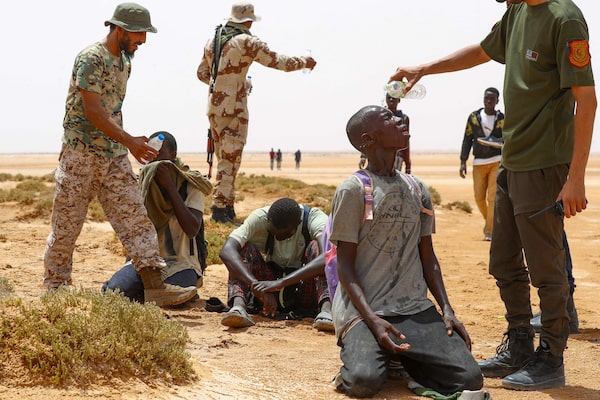
Border guards give water to African migrants water in al-Assah, Libya, this past July, after authorities in nearby Tunisia reportedly abandoned them in an uninhabited area.MAHMUD TURKIA/AFP via Getty Images
Many of these migrants, reaching the crossroads of Agadir, decide to stay. That’s because they’re badly needed here. To the south and west of Agadir are endless vistas of fertile fields covered in plastic sheets, stretching dozens of kilometres into the distance, as Morocco continues its “Green Plan” – an ambitious project to build its agricultural exports by expanding the land irrigated by the Sous River, providing drip-irrigation crops of fruits and tomatoes with two or three harvests a year.
Those harvests require far more agricultural workers than Morocco’s own population can provide, so there is a huge demand for sub-Saharan labour. And Morocco has responded to both the illegal-migration and farm-labour challenges – in part with support from the EU – with its National Immigration and Asylum Strategy, which allows some migrants to become more-or-less legal residents with access to schools and medicine, and sometimes to permanent-resident papers.
Between 2014 and 2022, the European Union gave US$2.2-billion to Morocco to control its border and manage migration, in hopes that this would bring fewer Africans to the continent. Part of this involved turning prospective migrants into residents: Since 2014, two Moroccan regularization campaigns have given permanent-resident status to more than 50,000 foreigners, mostly sub-Saharan (perhaps a quarter of the entire known migrant population in Morocco). A considerably larger number are allowed to reside more or less permanently as labourers, despite lack of legal status.
This has transformed places such as Ait Amira, a farming community about half an hour south of Agadir. Formerly a lonely market amid dusty plains, it is now a bustling, mostly unplanned town surrounded by labyrinthine webs of one-storey concrete-block rental apartments, populated almost entirely by families from Western and Central Africa. The men pick tomatoes and other fruit beneath the plastic sheets of the sprawling greenhouse fields – exhausting work that generally pays around $10 for a 10- or 12-hour shift – during the two harvests that together take up about six months of the year.
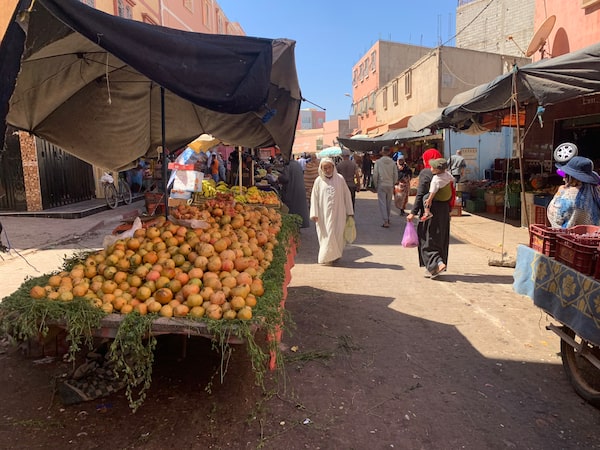
Patrons shop at the market in Ait Amira, a Moroccan town whose fruit and tomato fields employ thousands of West African migrants.Doug Saunders/The Globe and Mail
Women have prospects for more permanent and often higher-paid employment in the markets and in service jobs, including nursing and hotels, and children can be enrolled in local schools, in part with the support of a local Unicef program. So migrants bring their families to settle here – unlike the mainly male migrant camps of central Casablanca, the mud streets of Ait Amira are full of kids kicking soccer balls and little shops selling the cooking ingredients and home furnishings that families need. Rent for a crude but clean one-room apartment is around $60 to $70 a month, about half what you’d pay in the big cities of the north.
“There’s no need to go to Europe if you can get a place here,” said Tahlou Zaouli, 30, who spends her days working at a butcher shop in the nearby larger town of Lqliaa.
She came from the Ivory Coast with one of her sisters, who had discovered the better incomes and low living costs of the Agadir region. “With the little salary we earn, we manage to eat and pay for the house, and still have enough left to send a good amount back for my daughters.” Her two kids, still back in the Ivory Coast, are able to get the kind of education – and thus chance for advancement in life – that wouldn’t be possible on typical earnings there. “For the moment, we just dream of moving forward,” she told me. “But at least now that I have arrived here, I feel good knowing that I can go home to a better situation.”
“It’s not easy, the life in Morocco, but what pushes a lot of people to come and settle here is you can earn a little while waiting for tomorrow,” said Alain Ngoy, 35, who worked as an ambulance mechanic in the Democratic Republic of Congo before coming to Morocco in 2010 with vague intentions of crossing to Europe, but ended up a street vendor in Rabat, the capital. During the 2010s, Rabat cracked down on sub-Saharan workers without legal residence, forcing him to work in hiding and eventually getting him deported to Agadir in 2019. There, he discovered Ait Amira and now runs a shop here.
Life remains pretty precarious – recently, he was a day late on the rent for his shop, and the owner evicted him, throwing the goods onto the dirt street and getting the local police to threaten him. Police patrol the area and break up informal gatherings. And the residents – especially women – are wary of walking out of the neighbourhood before dawn or after dusk, even though the harvest work often begins in the dark, because there have been violent attacks on Black Africans by Moroccan men on the road to the central town and the fields.
Few of the sub-Saharan families in Ait Amira come from agricultural backgrounds – in fact, many of them have degrees and some enjoyed middle-class lives. Cheick Camara, 30, a leader in Ait Amira’s Guinean community, came here a few years ago with his wife after completing a master’s degree in cinema editing at the University of Bamako in Mali.
“After my studies were finished, I said to myself, I need to leave because in Guinea, cinema is not that evolved, and if I come to Morocco maybe I could get more knowledge on the subject – but when I got here, I realized that the situation is not that open for West Africans. So here I am with my wife working on a tomato farm, but I’m hoping to save enough for equipment so I can continue my cinema career.”
This has been a slow process. His daughter was born here, and the three rarely make enough to save much. “In between harvest seasons, it’s often difficult to get enough to eat well every day. In those first years, after we found other ways to make money, the life here was just survival. It still is, in many ways.”
That makes the farm work around Agadir the more tempting option for many. It’s an option, however, that’s mostly available only to migrants who have legal ID papers from their home countries – something that many, including Khalifa, do not possess. Even then, only some end up being allowed to stay for good. For the rest, it’s either go home, or attempt an increasingly dangerous rush for the border.
That was Khalifa’s experience. In 2021, still hoping to get into Europe for free, he approached the Algerian-Moroccan border in the northern city of Oujda with a group of young Black men planning to rush past the armed police guarding it. During this attempt, some time after midnight, he found himself trapped under razor wire as dogs ran at him. He struggled to free himself, got entangled, and fell hard on his hand as the sharp blades cut deep into his upper chest. Bloodied and terrified, his clothes ripped up, he staggered back. He still has the scars.
A month later, they tried it again. This time, he and his friend decided to wait in the shadows, crouching in silence while the police rounded up the rest of the migrants. At about 4 in the morning, Khalifa and his friend gingerly snuck under, unseen. Then they found themselves in a difficult position: It turned out the people of Oujda didn’t have much time for Black men who looked like they’d just crossed the border. A ride or a place to stay couldn’t be found – until, almost miraculously, help appeared.
A car stopped and the passengers asked if they needed a place to stay. “We can give you a place for a few weeks, help you get back on your feet,” the men said. It was a moment of blessed relief for Khalifa and his friend. But once the car arrived at the dingy house, they were thrown in a mud-floor cellar room – and they heard the lock turn.
They had been kidnapped, something many West Africans told me they’d experienced in northern Morocco. The gang – also sub-Saharan – was demanding a payment equivalent to about $8,000 from Khalifa’s family. They didn’t have anything like that kind of money, and Khalifa wasn’t letting the gang members contact his mother. So the gang wouldn’t let them eat.
They had only occasional pieces of bread, often accompanied by violent slaps. Their energy depleted, they curled on the filthy floor. After two weeks of this, the door opened. The police had become suspicious of this house, the men explained, so the teenaged captives were to be taken to a more secure place in the country. The two filthy, weakened boys were shoved into the blazing daylight, three big men in front of them and three behind, and told to walk silently. Khalifa’s friend whispered, “If we run into the crowd, they can’t go after us because people will see they’re criminals.” Khalifa balked. But then his friend ran, and Khalifa bolted after, finding energy he didn’t know he possessed. The big men couldn’t give chase, and the boys disappeared into the market crowd.
When they ran into a Roman Catholic church, the priest instantly knew what had happened – he had several other West Africans sheltering there under similar circumstances. The church cleaned them up, gave them meals and a few nights’ stay, and then offered them a bus ticket to Casablanca, Morocco’s largest city. Only there, the priest said, would guys like them be comparatively safe.
Casablanca: The new border
Near the centre of Casablanca is a largely abandoned bus station, a cavernous 1950s marble and concrete building whose battered lobby and basement have become a chaotic, dimly lit shelter and gathering space for West African men and women as well as a noisy population of troubled and dangerous individuals of various backgrounds, like some twilit ruin from a postapocalyptic sci-fi movie. Across the road, in a former traffic roundabout, is a sea of makeshift shacks crafted from scrap wood and plastic tarpaulins, the narrow laneways of tents patrolled by volunteers from its largely male population.
Together, these settlements are known as Ouled Ziane, after the bus station’s name. Like the Mama Africa hotel down in Agadir, this is a transit camp – a place where migrants live while they decide where to go and what to do next. But this is nowhere near as friendly a place, and many of its residents have been stuck here for months or years, as the policies of Morocco and the EU have toughened.
Much larger West African populations, mainly Senegalese, live in more comfortable conditions in less central parts of Casablanca; they are permanent migrants, part of the city’s labour force, and generally entire families. The bus-station camp is essentially a staging ground for attempts to enter Europe. Its population isn’t huge, and many of the men here tell me they’re close to giving up, but for the debts they owe to smugglers.
Khalifa was dropped here after escaping northern Morocco the first time, and found himself living in the bus station on and off for several months. “It was very difficult, how we struggled to survive in the bus station. There are no jobs, no way to study or get a visa, so people there had a few opportunities, like very badly paid hard work, day labour or [sex work],” he said. “Everyone here is just waiting to get to the Europe border, but it’s a long wait.”
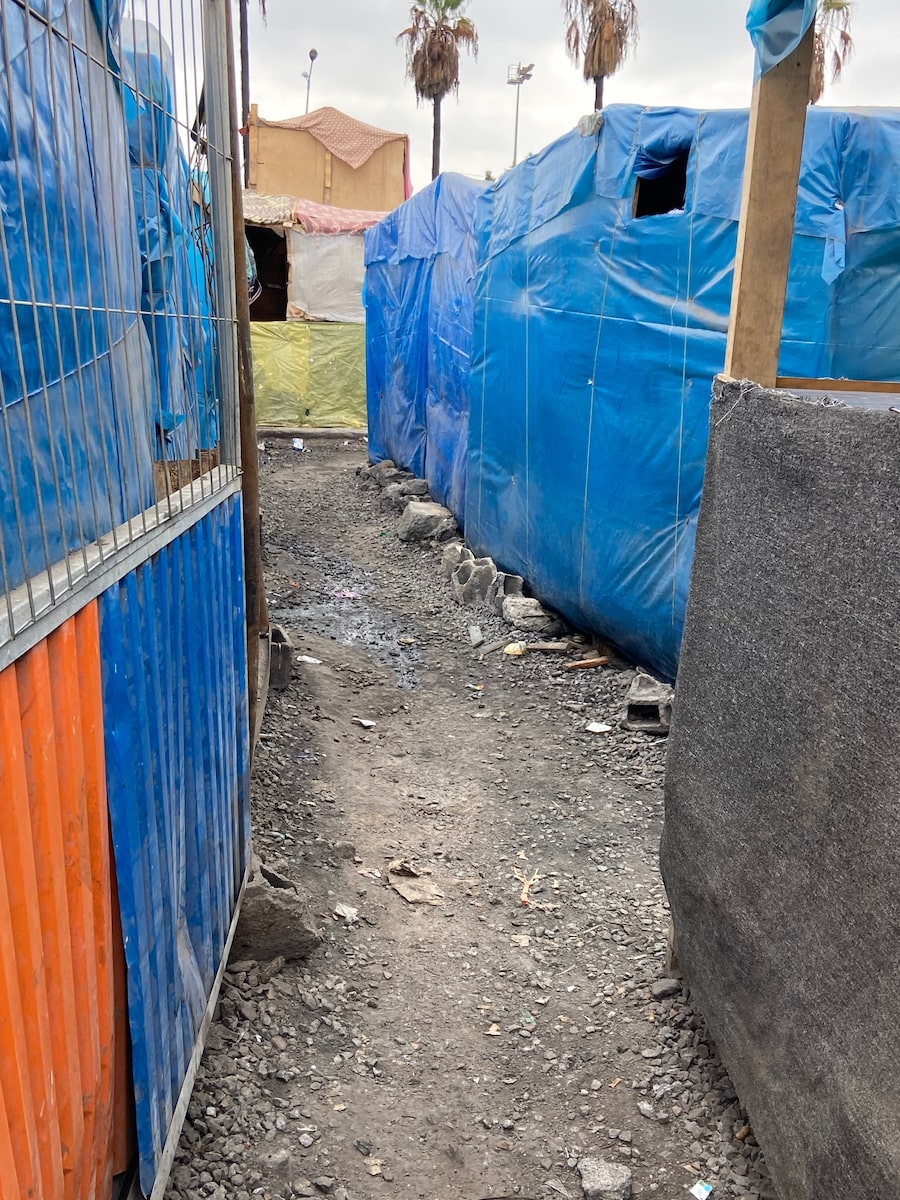
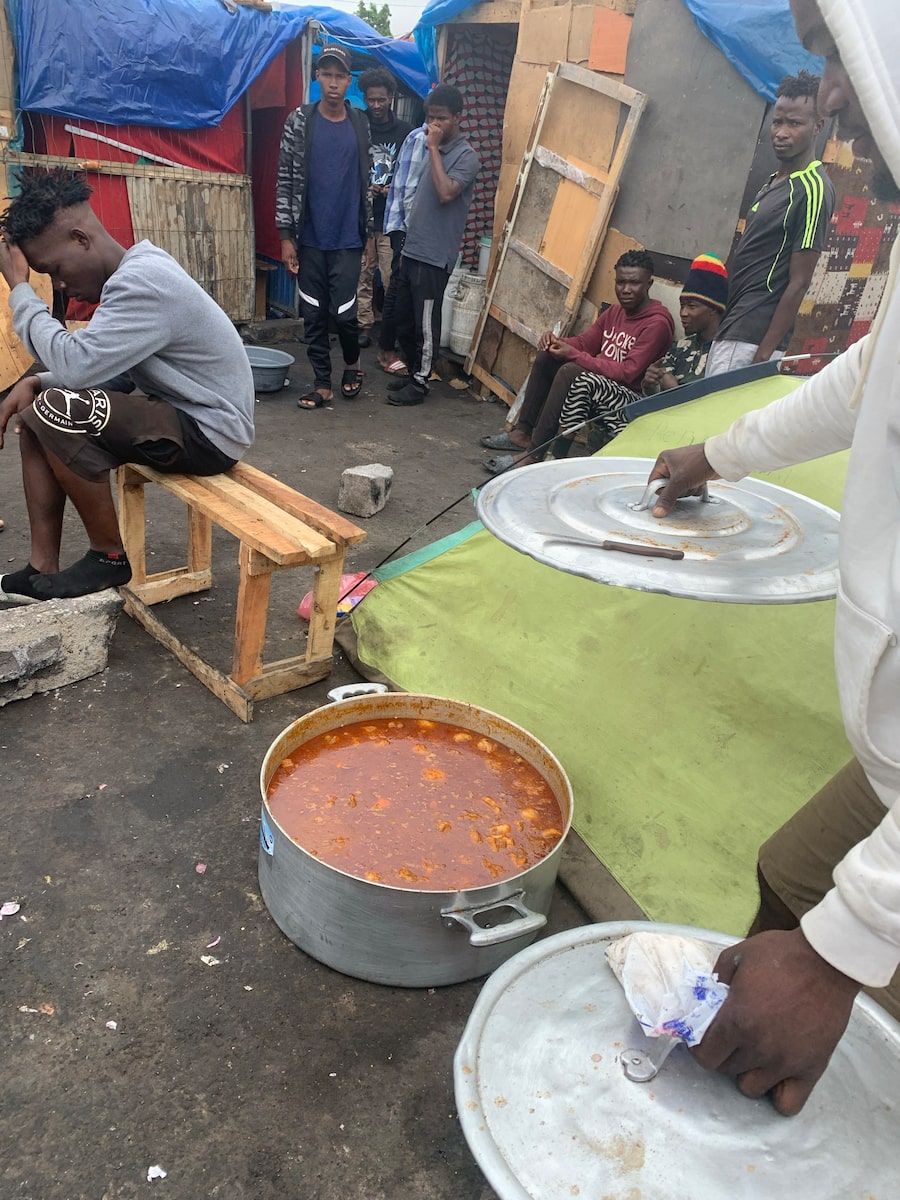
The Ouled Ziane camp has a direct relationship with the enclaves of Melilla and Ceuta – two small port cities belonging to Spain, perched on peninsulas of the northern Moroccan coast. Since the 1990s, African migrants (including many Moroccans) have tried to enter Europe, as workers or asylum seekers, by walking into these enclaves. Starting in the 2000s, Spain built several layers of fearsome fences and both Morocco and Spain have deployed hundreds of soldiers to guard the entries. Migrants have periodically tried to breach the border by massing in the forests outside and then trying to overwhelm security.
This came to a terrifying climax on June 24, 2022. That day, at least 2,000 migrants, mostly from war-stricken Sudan, charged a Melilla border crossing, scaled a fence and forced open a preliminary gate. By the end of the day, at least 23 migrants were dead (advocacy organizations say the number is at least 37, as some died of their injuries later), some on Spanish territory, and 77 were hospitalized with injuries. (It followed a 2021 incident in which 8,000 migrants stormed the Ceuta border and two were killed.) Moroccan officials claim the victims were crushed to death in the stampede, while advocacy organizations call it a “massacre” in which many were killed by soldiers, who had beaten and tear-gassed the migrants.
The deaths changed the dynamics of the northern border. The Moroccan military cracked down, with the encouragement of EU agencies, and swept sub-Saharans out of the country’s north; the land borders became far more difficult to reach.
Salaheddine Lemaizi, a Casablanca-based migration-policy expert, gestured around Casablanca’s Ouled Ziane camp: “After June 24, this became the northern border of Morocco.”
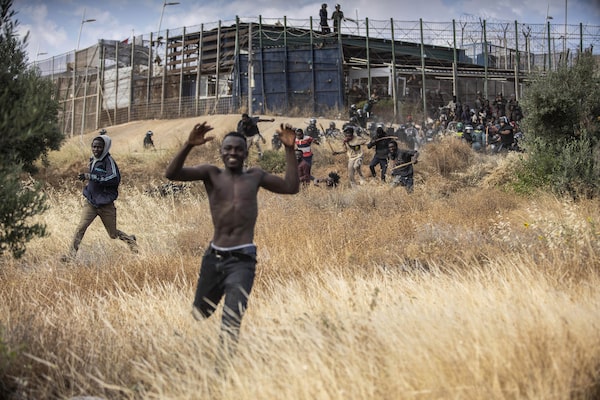
Migrants run onto Spanish soil in Melilla on June, 24, 2022, after crossing the fences from Morocco.Javier Bernardo/The Associated Press
A couple months before the June 24 deaths, Khalifa had saved enough cash to join scores of men from the camp on a journey north. They paid a “taxi mafia” smuggler to take them to the forested hills near the Melilla border. They camped there for more than a month, waiting for an opportunity to charge the multiple walls of steel and razor wire. “Even then, in the camp, I was thinking to myself that this isn’t a great idea, what am I getting out of this, why am I risking my life for this,” he recalled.
His years-long journey had set him on a collision course with Moroccan and European policies. As a child from Guinea without ID papers or a passport, he wasn’t eligible for either Spanish or Moroccan programs designed to turn migrants into legal labour immigrants. His only options would be to get himself physically into Europe and apply for asylum – something hundreds of unaccompanied minors, many much younger than him, do every year – or wait until he had the papers, and possibly the education, to do it legally.
But by then he had little choice. When the rush to the fence began in the predawn hours, he joined, using his small stature to evade the baton-wielding soldiers. He scrambled over a fence, ripping his clothing, then mounted another as guards beat his companions. Finally, he landed in the no-man’s-land between fences that is technically Spanish territory. For a few minutes, he was in Europe. “When I saw the Spanish police running at me, I knew for sure I had made a big mistake,” he remembered. He was just a kid. He didn’t need to risk it all like this.
European policies intended to keep borders secure had effectively forced him, and the thousands of people around him that day, into making dangerous choices that served nobody’s best interests. Across the continent’s seas and channels and border fences, such perverse incentives turn thousands of putative temporary labour migrants every year into security threats or tragic victims.
Khalifa got locked up for a few days, then deported back to Casablanca. After staying in the squalor of the bus station for a couple more months to save some money from odd jobs, he took a van down to Agadir to stay at Mama Africa’s. “I had reached a decision,” he told me. “No more wasting my life walking across the desert. I would go back to my family and finish my education, and do so well that I can get invited into Europe or America to study there. For me, I now know that’s the only way to realize my dream.”
After we last met in Tan-Tan, Khalifa boarded a “taxi mafia” van southward to Mauritania. They were stopped by immigration police, who deported him back to Dakhla, in Western Sahara. There he went to the Guinean consulate, where he was issued a temporary travel document allowing him to cross the three international borders required to get home. He has texted his mother to tell her that he will be seeing her again soon, after almost three years away, and that she was right.
Undercurrents: More from The Globe and Mail
The Decibel podcast
On this episode of The Decibel, Doug Saunders explains what he learned in Vietnam about the myths and realities of climate migration. Subscribe for more episodes.
More from Doug Saunders
On a busy migration path, Venezuelans seek fragile hope
I followed a migrant family across the Americas. Then a cartel seized them
 Doug Saunders
Doug Saunders